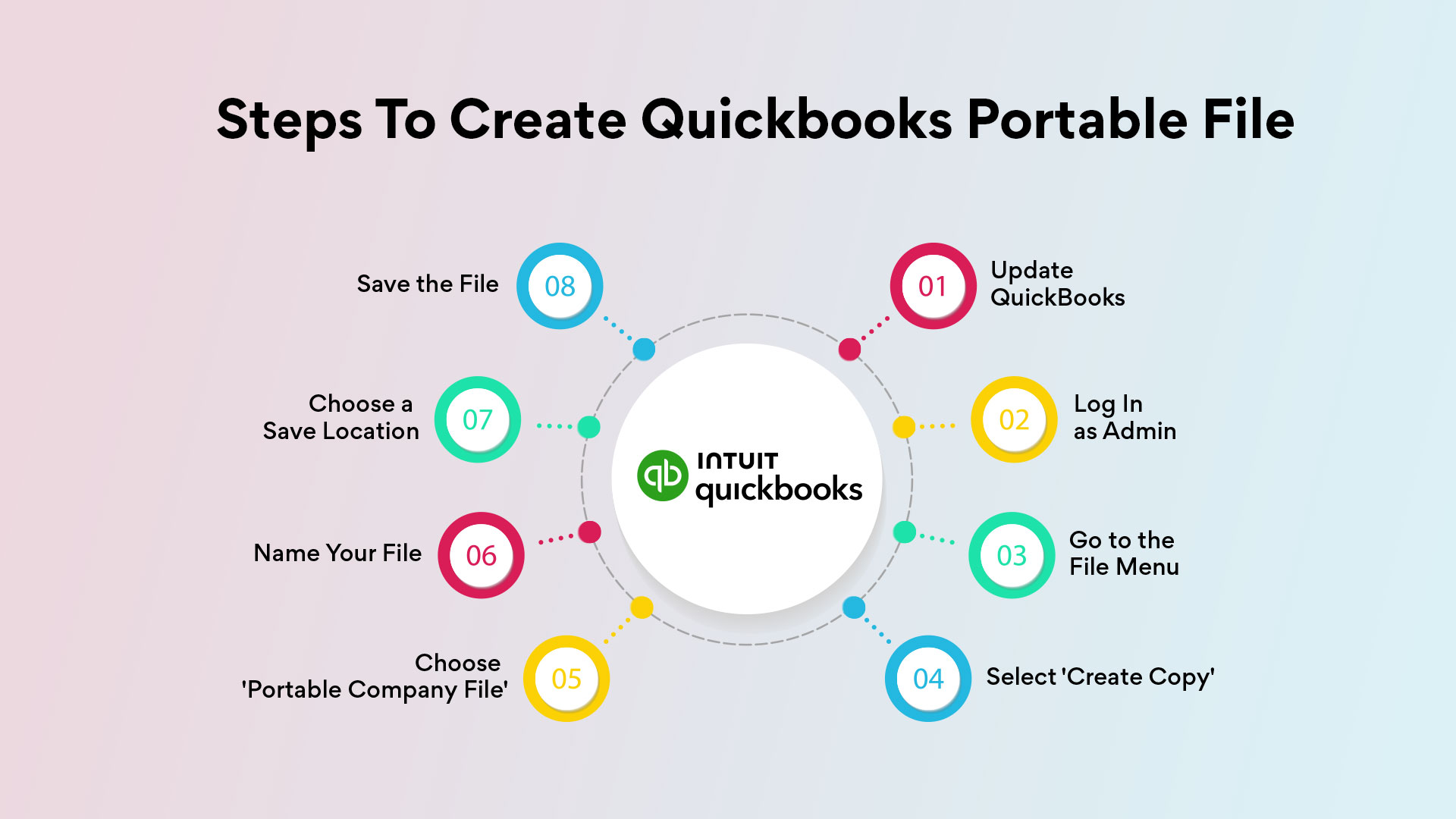
The month-end close is the process accountants follow to review, reconcile, and finalize financial records at the end of each month.
It’s how all the scattered transactions... sales, expenses, payments, and adjustments, get tied together into one accurate financial picture that businesses can rely on.
If you’re an accountant, you probably know the drill, those last few days of the month can feel endless.
Long nights, endless reconciliations, double-checking entries that somehow never seem to end… we’ve all been there. That’s the month-end close.

But here’s what I’ve learned: the month-end close process isn’t just another checklist we grudgingly tick off.
It’s the very thing that pulls all those scattered transactions together into one clear financial story.
When we handle it right, the reports stay accurate, compliance becomes easier, and the numbers actually start to feel trustworthy.
In this blog, I want to walk you through what the month-end close really means and why it matters for US businesses and accounting professionals.
We’ll also look at how to make the process smoother with the right approach, and yes, I’ll share a practical month-end close checklist you can actually use.
Why is the Month-End Close Process Important?
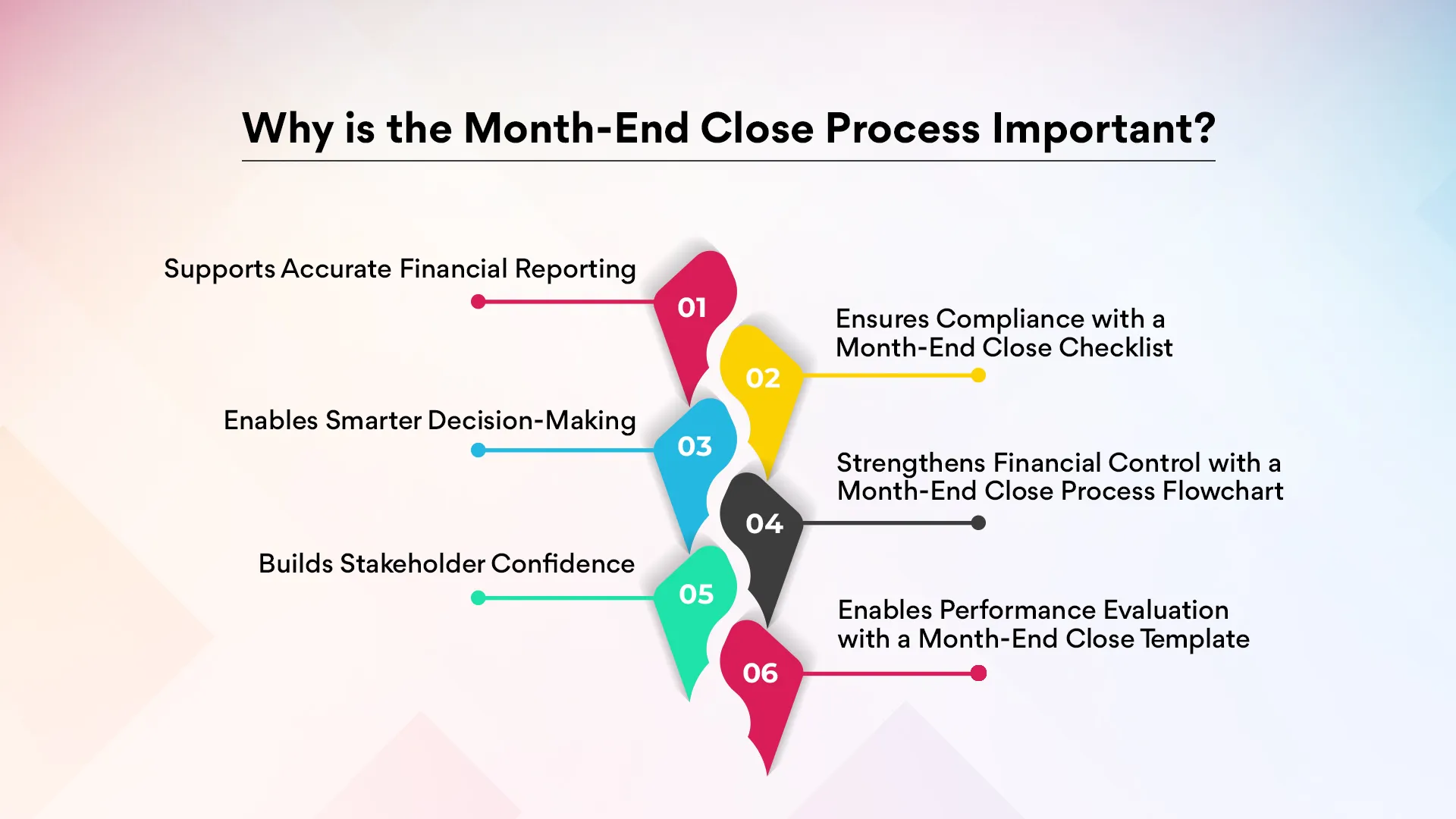
The month-end close process is essential because it brings accuracy, consistency, and confidence to financial reporting.
By closing the books regularly, businesses ensure they’re working with reliable numbers instead of outdated or incomplete data.
Here’s why it matters:
1. Supports Accurate Financial Reporting
Month-end close ensures every transaction is recorded in the right place and period.
This reduces the risk of errors, misstatements, or missing entries, which can otherwise mislead management, stakeholders, or auditors.
I like to think of the accounting month-end close as the final puzzle piece. Once every number fits, the full financial picture is finally clear. Skip a step or rush through it, and suddenly income or expenses don’t add up.
That not only misleads stakeholders but can also trigger compliance headaches with US GAAP and IRS regulations.
👉 With Xenett, we don’t have to juggle messy spreadsheets anymore. Its centralized dashboard and built-in month-end close automation review transactions step by step keeping reports consistent and reliable.
2. Enables Better Decision-Making
Accurate numbers give leaders a clear view of the company’s financial health.
With up-to-date data, businesses can make informed choices about budgets, spending, and investments instead of relying on guesswork.
Ever had leaders waiting on reports that were delayed? It leaves them making risky choices based on outdated information.
A timely month-end close process changes that, it gives decision-makers a clear, updated view of profitability, performance, and cash flow.
👉 With Xenett’s financial close automation, we can deliver accurate reports faster. Leaders get real-time visibility and can act decisively.
3. Improves Cash Flow Visibility
Closing the books highlights what money is coming in, what’s going out, and what’s still owed…giving you a clear picture of your cash flow.
Trust me, having this visibility makes it way easier to manage things like payroll, supplier payments, or upcoming expenses, with no nasty surprises.
4. Ensures Compliance and Reduces Risk
Many businesses face strict reporting requirements for taxes, audits, and regulations.
A disciplined close process keeps you on track, lowers compliance risks, and actually makes your stakeholders trust you more.
5. Strengthens Forecasting and Planning
Fresh financial data provides a solid base for forecasting.
You can see how your actual results stack up against budgets or projections and tweak your strategy before small issues snowball into bigger problems.
6. Builds Operational Discipline
Doing month-end closes regularly helps set clear processes and responsibilities, so there’s less scrambling at the last minute.
Over time, it just makes your accounting function smoother, faster, and less prone to errors.
Key Steps in the Accounting Month-End Close Process
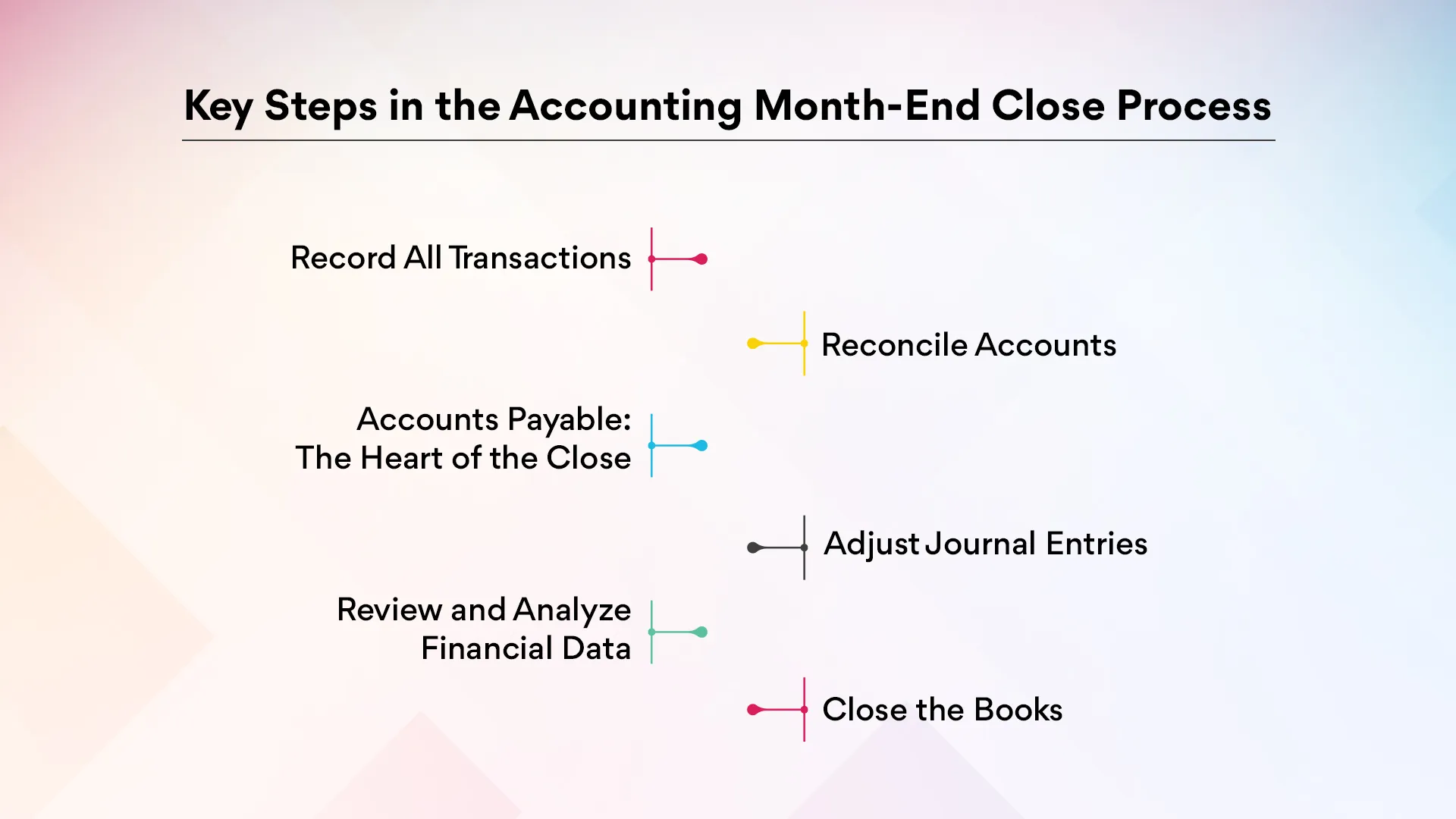
The month-end close is all about bringing order and accuracy to your books. While every business may have its own checklist, most accounting teams follow these core steps:
1. Record All Transactions
The first thing you want to do is capture every financial move, sales, expenses, payroll, investments, loans… you name it.
Miss one, and your reports won’t tell the full story. Accurate documentation here sets the tone for the rest of the close.
👉 With Xenett, you don’t have to hunt through spreadsheets. You can dive straight into the general ledger, check transactions by vendor, and even tweak entries in real time. Recording just got way less painful.
2. Reconcile Accounts
Reconciliation is all about making sure your internal records match up with external sources like bank statements or credit card reports.
For bigger companies, intercompany reconciliation is key too, subsidiary accounts have to align with parent company records to keep consolidated financials accurate.
3. Accounts Payable: The Heart of the Close
Account payable is usually one of the most time-consuming parts of month-end. Tracking invoices, getting approvals, and scheduling payments can get messy.
If account payble slips up, it can distort cash flow, harm vendor relationships, and mess with your balance sheet. Keeping it organized keeps reporting smooth and stress-free.
👉 Tools like Xenett can automate approvals, reconcile payments automatically, and give you real-time account payable visibility. It turns one of the biggest headaches into something way more manageable.
4. Adjust Journal Entries
Even after recording and reconciling, things need a little fine-tuning. Adjustments make sure the financial records reflect reality. That means updating for:
- Depreciation and amortization
- Accruals for expenses and revenues
- Prepaid expenses allocation
👉 The good news? Xenett gives us real-time alerts whenever something changes in reconciled accounts, so we don’t miss important adjustments.
5. Review and Analyze Financial Data
This is where the puzzle pieces come together. After reconciliations and adjustments, it’s time to review the data and create the financial statements:
- Income statement (revenue, expenses, net income)
- Balance sheet (assets, liabilities, equity)
- Cash flow statement (liquidity and cash position)
👉 With Xenett’s financial close management software, month-end close automation gets done up to three times faster.
Automated reconciliations and review workflows cut down errors, which means we can focus on analysis instead of firefighting.
6. Close the Books
Finally, the big moment, closing the books. This locks prior-period data so no unauthorized changes sneak in. At this stage, leadership gets a clean snapshot of the company’s financial health.
👉 And instead of dragging this step out, Xenett makes it 3x faster and way less stressful with automated reconciliations and review workflows.
Month-End Close Process Flowchart
A structured Month-End Close Process Flowchart helps simplify financial tasks, reduce errors, and ensure accurate reporting. It highlights the key steps accountants
follow to close the books smoothly each month.
Common Challenges in the Month-End Close
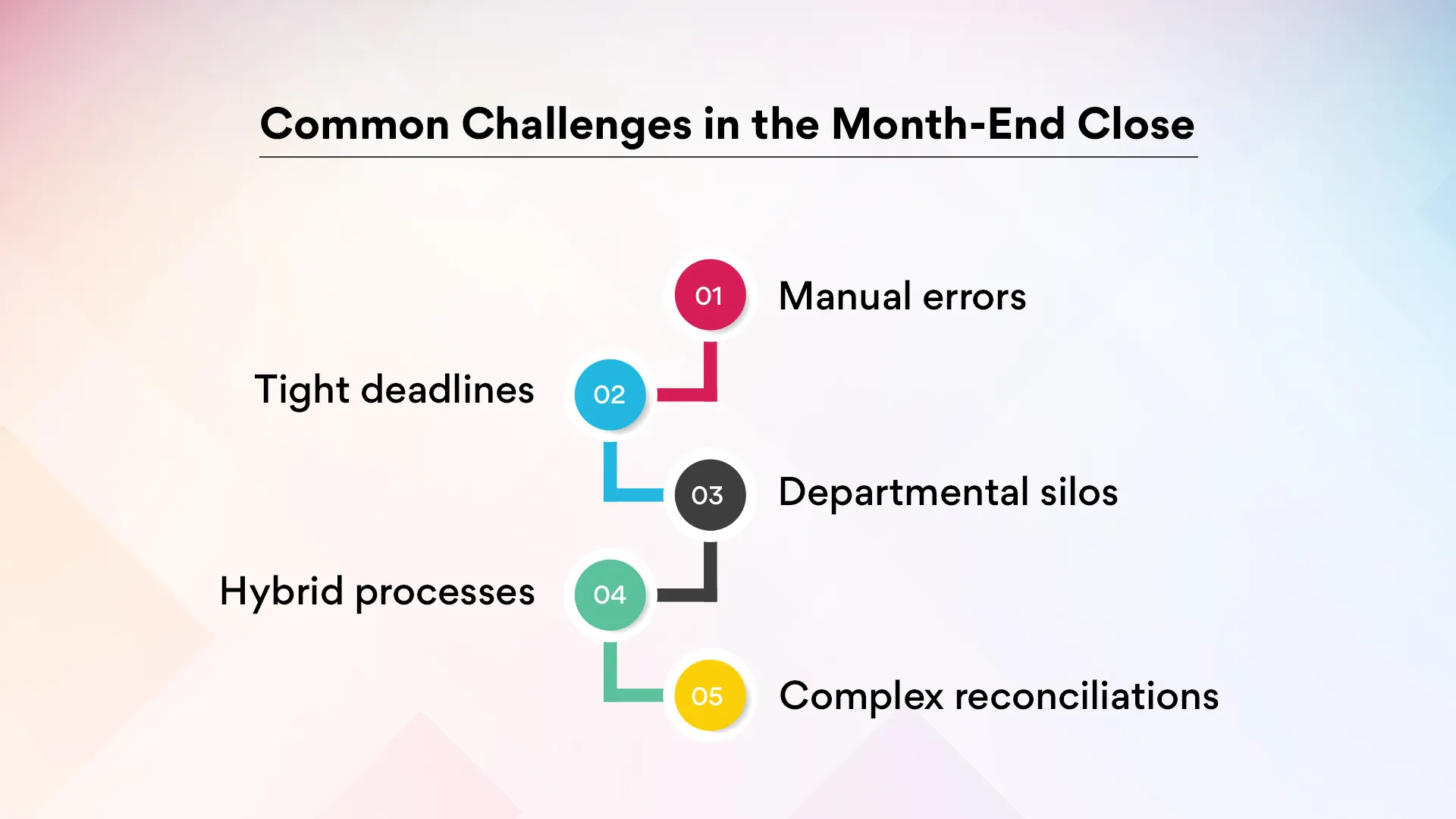
Manual spreadsheet errors, crazy tight deadlines, departments not talking to each other, a mix of manual and automated processes, and tricky reconciliations, all of these can really slow things down.
- Manual errors from over-reliance on spreadsheets.
- Tight deadlines, often resulting in rushed and inaccurate reporting.
- Departmental silos, leading to poor communication and delays.
- Hybrid processes (part manual, part automated), which increase error risks.
- Complex reconciliations, especially with intercompany accounts.
How Xenett helps: Automation, real-time collaboration, and audit-ready documentation minimize these issues and simplify closing.
Benefits of a Month-End Close Checklist
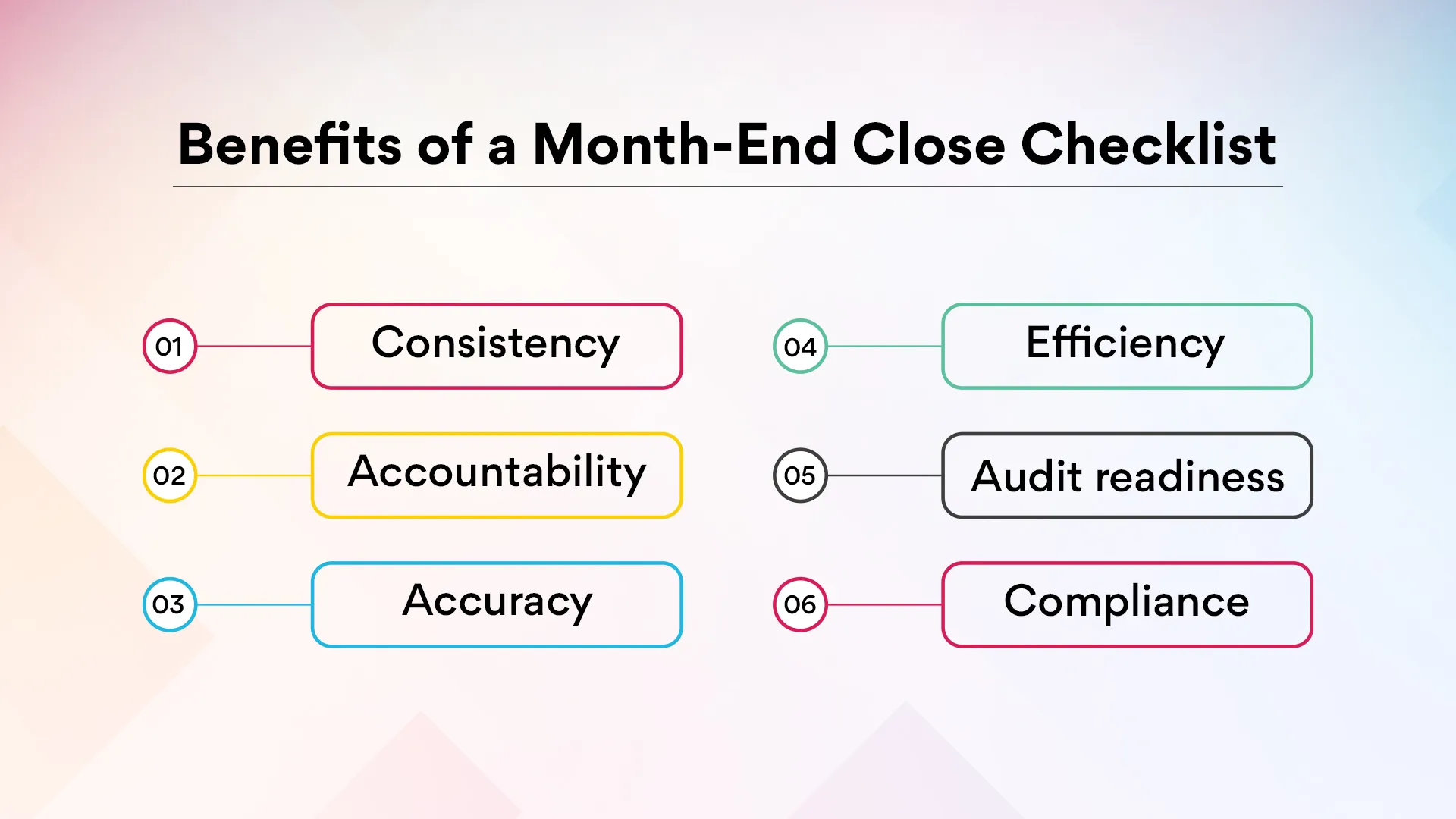
The Month-End Close Checklist simplifies tax filing, reduces accounting errors, and provides a clear view of the company’s cash flow.
Also...
- Consistency – Every reporting period follows the same structured process.
- Accountability – Each team member knows exactly what they’re responsible for.
- Accuracy – Fewer errors, fewer missed entries, and more reliable financial statements.
- Efficiency – A repeatable workflow that helps you close faster.
- Audit readiness – Every step is documented, so you’re always prepared.
- Compliance – Tasks stay aligned with GAAP/IFRS and tax standards.
With a checklist, whether it’s a template or a month end close checklist PDF, you give your accounting team more structure, clarity, and confidence to wrap up the month-end smoothly.
How to Improve the Month-End Closing Process
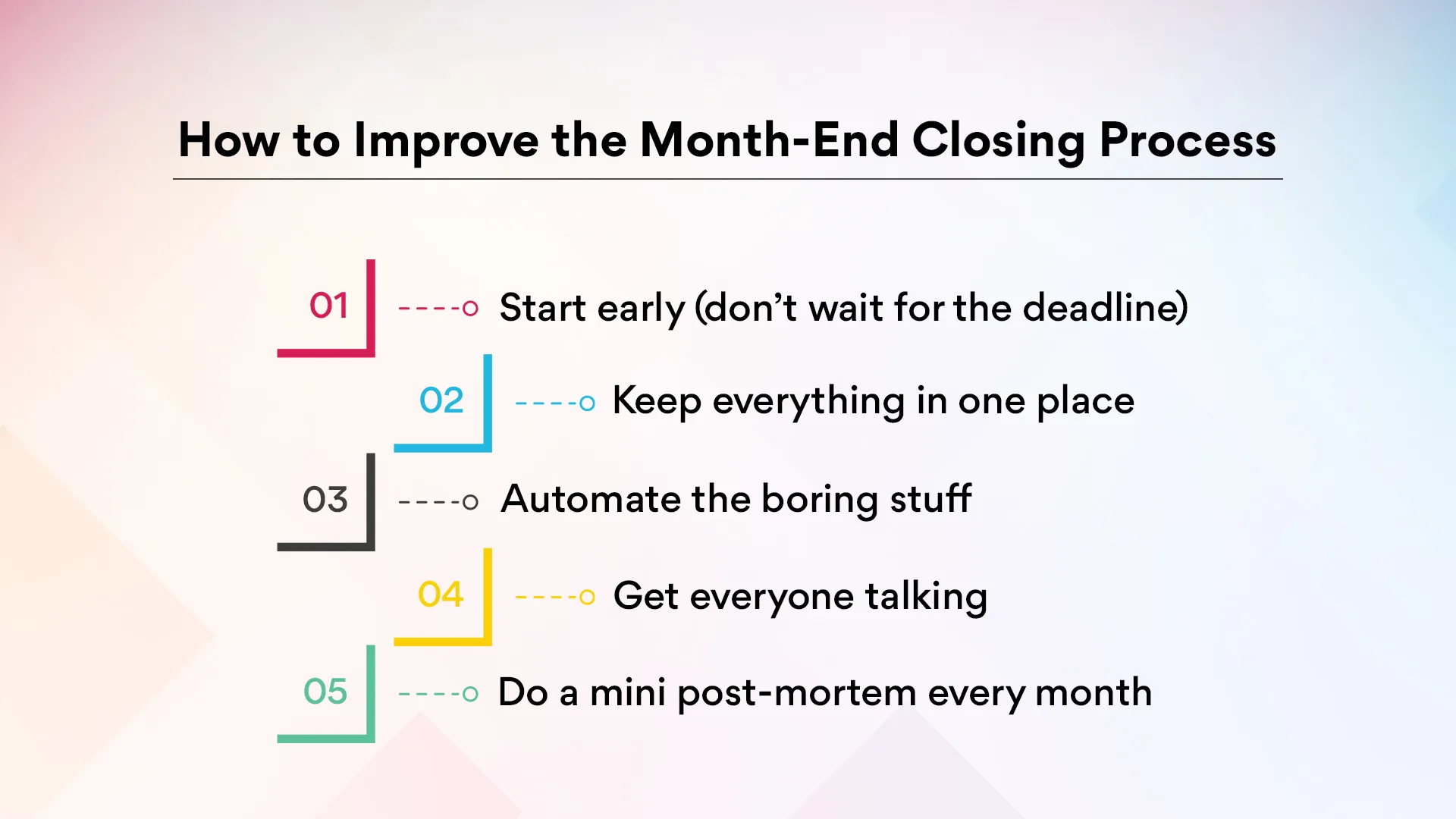
Plan early, keep all your documents in one place, and let software handle the repetitive tasks.
Learn more-->
- Start early (don’t wait for the deadline): Instead of cramming everything into the last two days, try reconciling accounts throughout the month.
Think of it like doing your laundry in smaller loads instead of waiting for a giant messy pile.
- Keep everything in one place: Half the stress usually comes from hunting down invoices, receipts, or approvals.
If your documents live in five different folders (and three email chains), you’re setting yourself up for chaos. Centralizing everything saves so much time.
- Automate the boring stuff: Why spend hours manually matching transactions when software can do it in minutes?
Tools like Xenett can take over reconciliations, adjustments, and even reminders. so you can focus on actual analysis instead of firefighting.
- Get everyone talking: Month-end isn’t just a finance problem. Operations, sales, and management all play a part. Regular check-ins mean fewer last-minute surprises.
- Do a mini post-mortem every month: After the close, ask yourself and your team, what went smoothly, what dragged us down, and what can we fix next time? Even small tweaks can save hours in the long run.
Best Practices for Improving the Month-End Close Process.
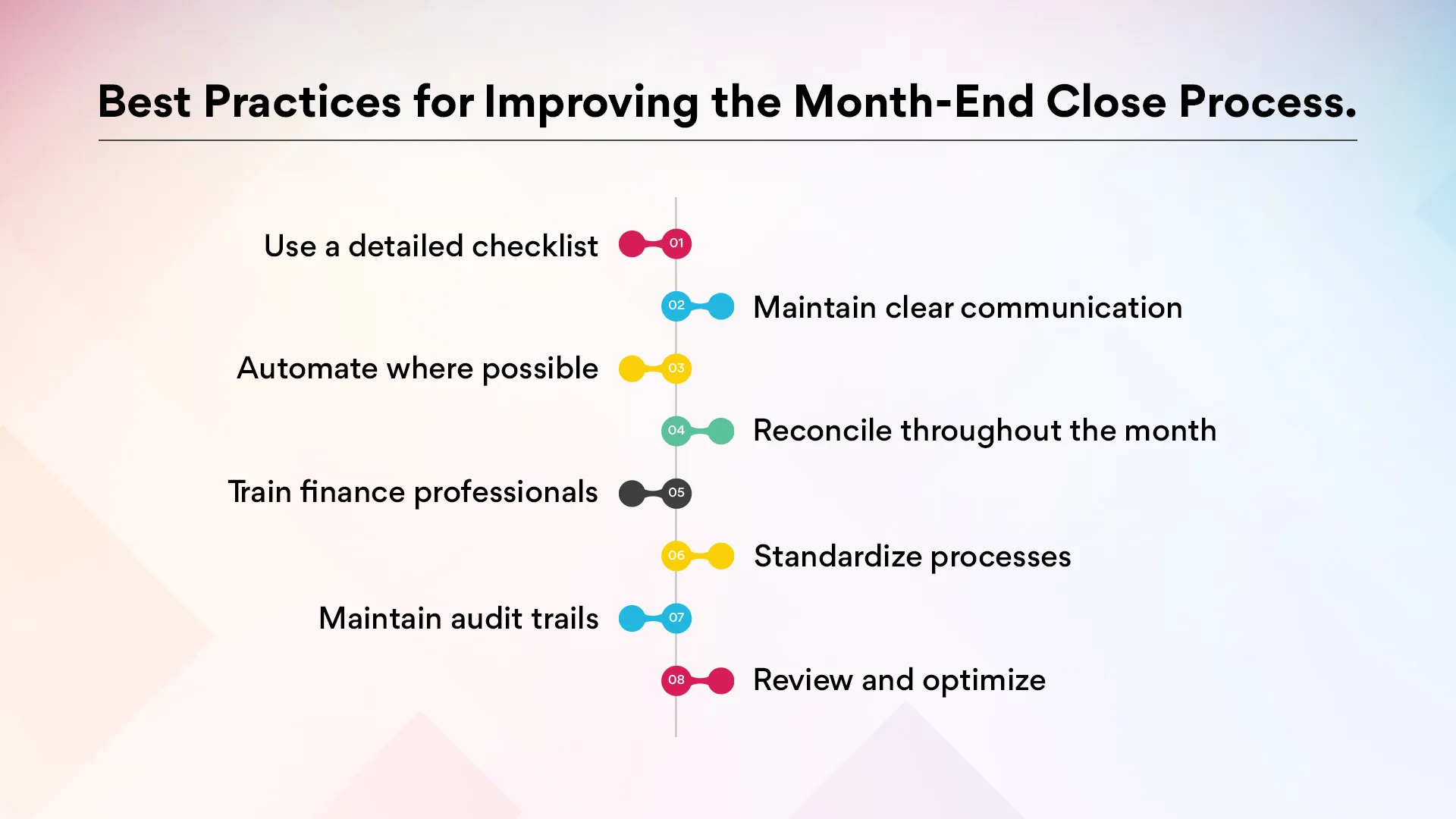
Use checklists, clear communication, and automation to make closing faster and smoother. Keep accounts updated, train your team, and review processes to improve every month.
In detail...
- Use a detailed checklist – Think of it as your roadmap. A simple PDF or template keeps the team on track and helps you hit deadlines without last-minute chaos.
- Maintain clear communication – You, me, and the whole team need to be in sync. Keeping accounting and other departments talking saves a ton of back-and-forth later.
- Automate where possible – Why spend hours on manual reconciliations when tools like Xenett can do it for you? Automating recurring tasks is a total game-changer.
- Reconcile throughout the month – Don’t wait for month-end to fix everything. Updating accounts regularly makes closing way easier.
- Train finance professionals – The rules keep changing. Keeping your team up to date means fewer surprises.
- Standardize processes – Templates and documented steps make sure everyone’s following the same playbook.
- Maintain audit trails – Recording every change isn’t just for compliance, it makes you look super organized when questions come up.
- Review and optimize – And of course, always step back to see what could be faster, smoother, or less painful next time.
What Xenett Brings to Your Month-End Close
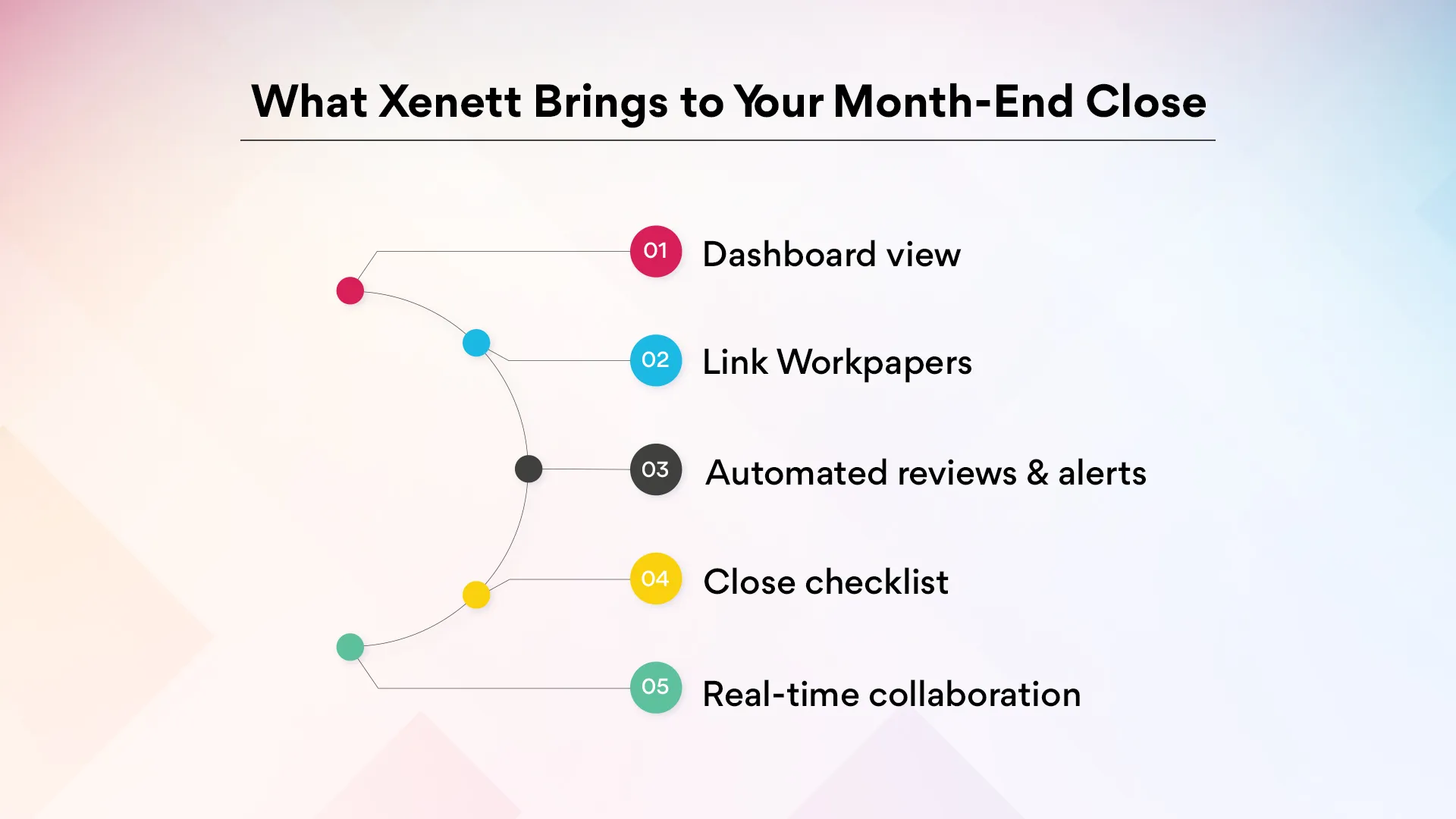
Traditional accounting software can often feel outdated and cumbersome. Xenett changes that. It goes beyond just processing numbers, it streamlines the month-end close, making it faster, more accurate, and significantly less stressful.
Here’s what makes it different:
- Dashboard view – Instead of juggling endless spreadsheets, you get everything in one clean view.
- Link Workpapers – Need supporting docs? Just attach them directly to GL accounts, no more digging through folders.
- Automated reviews & alerts – The system flags discrepancies for you, so you don’t waste time hunting them down.
- Close checklist – Every step is tracked with sub-tasks, so nothing gets missed.
- Real-time collaboration – Everyone…from accountants to stakeholders, can review, comment, and resolve issues instantly.
The best part? Month-end doesn’t feel like a fire drill anymore. It’s faster, more reliable, audit-ready, and honestly… way less stressful. Plus, you’re saving time and tightening financial governance.
FAQs on the Month-End Close Process
1. What is the month-end close in accounting?
The month-end close is when a business reviews its financial records each month. It reconciles and finalizes the accounts to ensure accuracy. It ensures accuracy, compliance, and reliable reporting.
2. What are the steps in month-end close for a small business?
Key steps include:
- Recording all transactions
- Reconciling accounts
- Adjusting journal entries
- Reviewing financial data
- Closing the books
3. Why is the month-end close process important?
It provides accurate financial data for better decision-making and ensures compliance. It also builds stakeholder trust and protects company assets.
4. Is it better to close at the end of the month?
Yes. A monthly close gives businesses timely insights and helps prevent errors from piling up. It also makes quarterly and annual closes much smoother.
5. How can I improve the month-end close process?
You can:
- Use a month-end close checklist template
- Automate reconciliations
- Reconcile accounts during the month
- Invest in tools like Xenett for financial close automation
6. What is the accounts payable month-end close process?
The accounts payable month-end close process includes:
- Reconciling AP ledgers
- Verifying outstanding invoices
- Recording vendor payments
- Matching AP balances with statements
Conclusion
The month-end close process is more than a compliance requirement. It builds the foundation for financial accuracy, stronger controls, and better decision-making.
Organizations can improve the month-end close process by first addressing common challenges.
They can then apply month-end close best practices to strengthen accuracy and control. With tools like Xenett, teams can streamline and automate the close.
The process then becomes faster, easier, and more insightful.
With Xenett, businesses gain:
- Faster closes (3x quicker)
- Greater accuracy through automation
- Better collaboration across teams
- Transparency and compliance with audit trails
A competitive business environment makes an efficient month-end close essential. It’s more than accounting, it’s a real strategic advantage.

.svg)







